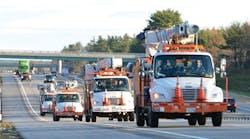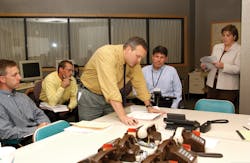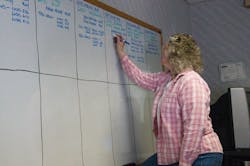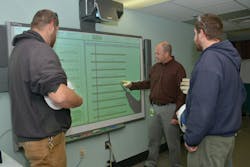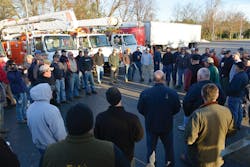Automated crew management is a game changer for the utility industry. Mobilizing and tracking crews efficiently, capturing crew staffing and the time crews worked, and playing it back after a storm has passed — this is all data Iberdrola USA is collecting to better gauge restoration costs and address information requests from executive management and regulators.
Last fall, Central Maine Power Co., New York State Electric & Gas and Rochester Gas & Electric began automating their crew-management processes. These utilities, which are part of Iberdrola USA, put in place Web-based software to give storm managers and others access to a computer-generated board for visually organizing and mobilizing crews required during large power-restoration events. The new automated system supports real-time distributed updating of crews by field supervisors and dispatchers, and tracks crew status, including contractors across each operating utility’s service territory.
Talk of automating the crew-management process began as early as 2011. In the beginning, the goal was to manage storms better. However, Iberdrola USA quickly realized a utility will never be successful with a system during a storm if the technology is not used day to day.
State of Practice
Before automating this process, mobilizing and deploying crews for power restoration and reporting on their status was largely a manual process that required significant time and effort to assemble and collate information from numerous sites. Even on blue-sky days, tracking crew assignments and work status requires the application of complex workplace rules for a real-time picture of work. Often, the centerpiece for assembling and reporting on blue-sky days as well as storm-crew resources is a spreadsheet, a whiteboard (rather, typically dozens of whiteboards spread across multiple service centers) or, in rare cases, a homegrown storm-management system.
The homegrown software system in place at Central Maine Power was not a Web-based application. It could not easily generate reports, for example, about the tree-trimming and line resources on a property. The homegrown system could not display the number of linemen working at a local level, let alone on an individual circuit. The best the system offered was a view of in which divisions crews were working.
At Iberdrola’s operating utilities in New York, groups of supervisors manually pieced together crews at local service centers and handed this data over to dispatchers to match it to their daily reporting location and availability for work. At times, keeping count of crews could take more than 500 spreadsheets. Whether in Maine or New York, providing crew deployment reports to regulators and executives during a major event was a significant burden for personnel engaged in managing the storm-restoration effort.
From Concept to Kickoff
Managing crews is complex. The utility industry must juggle the maintenance of equipment, unexpected outages, scheduling of crews and contending with bad weather. While a utility regularly has planned work, the plan gets shelved when a tree takes out a line, a house catches fire, a car runs into a pole or a major event like Superstorm Sandy strikes.
Even on blue-sky days, the scheduled plan can get rewritten on the fly if crews had to work extra hours the night before to tackle the fallout from a weather event. Time of day, call-offs, callouts and weather are always factors. During normal business hours on a blue-sky day, the crews working for Iberdrola USA go into the field with a plan. A radio, text message or phone call puts supervisors and dispatchers in contact with crews if things change. And they always do.
After normal business hours, if trouble hits, Iberdrola USA will launch a callout for one or more crews. And when the company sees a major event looming, it shifts into storm mode, and schedules crews and contractors for what is over the horizon. In a world where uncertainty is routine, utility professionals often have to rewrite the plan as they go.
With this in mind, Iberdrola USA began collaborating with NSTAR, PEPCO Holdings and software developer ARCOS in the spring of 2012 to develop a new system for automating the management of crews. The system entailed virtual boards to replace spreadsheets, whiteboards and the homegrown system. The virtual boards would give supervisors and executives a way to assess the makeup of crews during blue-sky days, and manage employee, contractor and mutual-assistance crews during storms. As ARCOS wrote the code, the utilities jointly tested the early versions and gave feedback.
Iberdrola USA and Delmarva Power piloted the finished product — a fast, accountable way to mobilize and track crews for storms — during the fall of 2013. The new system, Crew Manager, helps utilities organize visually and mobilize crews required during large power-restoration events and blue-sky days. The software-generated boards mimic the traditional whiteboards used today in operations centers and storm centers at many North American utilities.
Flipping the Switch
The virtual board’s point-and-click graphics let supervisors tap touchscreen interactive whiteboards from their PCs and mobile devices to see where crews are working and reassign them as power restoration progresses, as needed.
A virtual board allows supervisors to track crews by job classification, staging area, elapsed-time worked and status. Working shifts, rest time, emergency callouts and work exceptions appear as movable icons, so users can visualize ongoing work and forecast potential needs. Users can reorganize crews with a click to address the constant inflow of questions and information that come with restoration work. Much like an air traffic control system coordinates the movement of planes, Iberdrola USA’s Crew Manager shows the number of crews working or resting at any time, even during a major event.
The virtual boards are giving Iberdrola USA’s operating utilities a visual of what is happening with crews in real time. The virtual boards include color-coded icons designating different classes of employees, so supervisors can quickly tell if a crew has the right composition and bargaining unit agreements are met. The automated crew-management system also tracks the cumulative hours a crew has worked and a minute-by-minute account of how long each crew member has been on the clock.
Iberdrola USA began using the new automated callout system in October 2013, and CMP tapped the system during a storm for the first time in November as a cold front pushed through its territory with wind gusts up to 60 mph (97 kmph). Storm managers loaded contractors into the automated crew-management system to prepare for the damage and tracked where crews were along with what they were tackling.
Groundbreaking Common Sense
Managing crews with a centralized, virtual board is common sense, but it is also a groundbreaking way of operating. And this is why: A virtual board can precisely and continually capture crew staffing, assign crews as needed and replay all the moves after a storm has passed. Anyone working a storm can display the virtual board anytime and anywhere to update crew status, move or demobilize crews, or simply see what is happening. Utility managers can use this constantly updated information from a centralized database to calculate costs more accurately and respond to requests from executives and regulators.
Automating crew management is a logical step for North American utilities, especially the ones using the ARCOS suite for automating callouts. Once a utility automatically calls out crews, tracking each crew’s makeup, skills and real-time status is a natural outgrowth; it could even lead to a national crew management system.
Another benefit Iberdrola USA has found is automated crew management gives a manager a head start on setting up crews for the next day’s work. For example, before supervisors come to work, they can see from their smartphone when a crew is on rest because the crew’s work stretched from normal business hours into the night. The manager has a jump-start on reorganizing crews and expediting the departure of crews that morning. Without an automated crew-management system, crew members typically write a note stating they worked the night before and tack it to a board to be read the next day.
Recovering from major storm events requires a fast response from a large and varied workforce. By automating crew management, Iberdrola USA has the potential to deliver accurate crew invoicing by validating the composition of contractor crews, vehicle billing and utilization rates. The ability to record crew status and work also creates a historical database for long-term trend analysis that is invaluable for future pre-storm planning. This could give Iberdrola USA a way to manage labor costs more closely during a storm because supervisors can better predict which resources are needed.
Multiple Improvements
By automating crew management, Iberdrola USA believes it can improve safety and satisfaction. With Crew Manager in place, managers can point, click and move crews, and have these employees’ icons change colors quickly, showing which crews are tapped for storm duty. The system ensures each crew’s status is tracked and work hours are managed for safety. Iberdrola USA’s Crew Manager helps it to safely expedite restoration work so customers see their power come on sooner. And, because Crew Manager is cloud-based, any storm room personnel or executive with Internet access can see the planning taking place and monitor the activation of crews, even if Iberdrola USA has to evacuate its storm center.
Automated crew management is an around-the-clock, all-weather answer to the question: Where are the crews?
Kerri Foster ([email protected]) is the manager of T&D support programs and projects for Central Maine Power. During her 12 years at the utility, she has handled regulatory affairs and risk management. She now manages electric operations projects for the three operating utilities owned by Iberdrola USA: Central Maine Power Co., New York State Electric & Gas and Rochester Gas & Electric.
Joe Purington ([email protected]) is director of electric distribution for Central Maine Power. He is responsible for the transmission and distribution system construction, operations and maintenance along with the energy control center.
Companies mentioned:
ARCOS LLC | www.arcos-inc.com
Central Maine Power Co. | www.cmpco.com
Delmarva Power | www.delmarva.com
Iberdrola USA | www.iberdrolausa.com
New York State Electric & Gas | www.nyseg.com
NSTAR | www.nstar.com
PEPCO Holdings | www.pepco.com
Rochester Gas & Electric | www.rge.com
